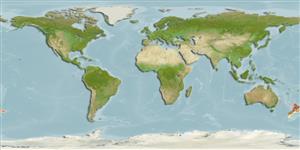Nymphon immane Stock, 1954
| Native range | All suitable habitat | Point map | Year 2050 |

|
| This map was computer-generated and has not yet been reviewed. |
| Nymphon immane AquaMaps Data sources: GBIF OBIS |
Upload your photos
Google image |
No photo available for this species.No drawings available for Nymphonidae.
Google image |
No photo available for this species.
Classification / Names Common names | Synonyms | CoL | ITIS | WoRMS
Pycnogonida | Pantopoda | Nymphonidae
Environment: milieu / climate zone / depth range / distribution range Ecology
Benthic; depth range 0 - 540 m (Ref. 9). Subtropical
Distribution Countries | FAO areas | Ecosystems | Occurrences | Introductions
Southwest Pacific: Australia and New Zealand.
Length at first maturity / Size / Weight / Age
Maturity: Lm ? range ? - ? cm
S. West Pacific: The above specimens increase geographic distribution for the species to the east and west of North Island, more than double the previously known depth range. Clark's specimen came from New South Wales, Australia, in 540 m. Size small, leg span about 27 mm. Trunk moderately slender, lateral processes separated by their diameters or slightly less, with small rounded dorsodistal tubercles. Neck moderately long, with small rounded tubercle dorsal to each chelifore insertion, oviger implantations at posterior, against first lateral processes. Ocular tubercle a tall slender cone with distal eyes. Proboscis short, distally rounded. Abdomen short. Chelifores very large, scapes divergent. Chelae palms short, fingers long, both curved ventrally, overlap at tips. Immovable fingers with about 25 slender teeth, movable fingers with more than twice as many much smaller teeth. Palps with segment 2 shorter than 3, segments 4 and 5 subequal in length, with few distal setae. Ovigers with slender long fifth segment swollen distally, with few lateral setae. Strigilis claw with 9 - 10 ventral lobes. Legs slender, with few setae. Propodus about twice tarsus length, both without spines on soles, with few tiny setae. Claw moderately short, auxilliary claws very curved, about 0.6 as long as main claw. Male cement gland ventral with 7 low tubes, but mostly more, up to 11 per leg, with shortest tube proximal, longest tube distally (Figure 1G). Distal tubes as wide as tall (Ref. 9)
Life cycle and mating behavior Maturity | Reproduction | Spawning | Eggs | Fecundity | Larvae
Members of the class Pycnogonida are gonochoric and sexually dimorphic. During copulation, male usually suspends itself beneath the female. Fertilization occurs as the eggs leave the female's ovigers. Males brood the egg masses until they hatch. Life cycle: Eggs hatch into protonymphon larva then to adults.
Main reference
References | Coordinator | Collaborators
Child, C.A. 1998. (Ref. 9)
IUCN Red List Status (Ref. 130435)
CITES status (Ref. 108899)
Not Evaluated
CMS (Ref. 116361)
Not Evaluated
Threat to humans
Human uses
| FishSource |
Tools
More information
Age/Size
Growth
Length-weight
Length-length
Morphology
Larvae
Abundance
Growth
Length-weight
Length-length
Morphology
Larvae
Abundance
Internet sources
BHL | BOLD Systems | CISTI | DiscoverLife | FAO(Publication : search) | Fishipedia | GenBank (genome, nucleotide) | GloBI | Gomexsi | Google Books | Google Scholar | Google | PubMed | Tree of Life | Wikipedia (Go, Search) | Zoological Record
Estimates based on models
Preferred temperature
(Ref. 115969): 11 - 19.4, mean 13.7 (based on 62 cells).
Price category
(Ref. 80766):
Unknown.


